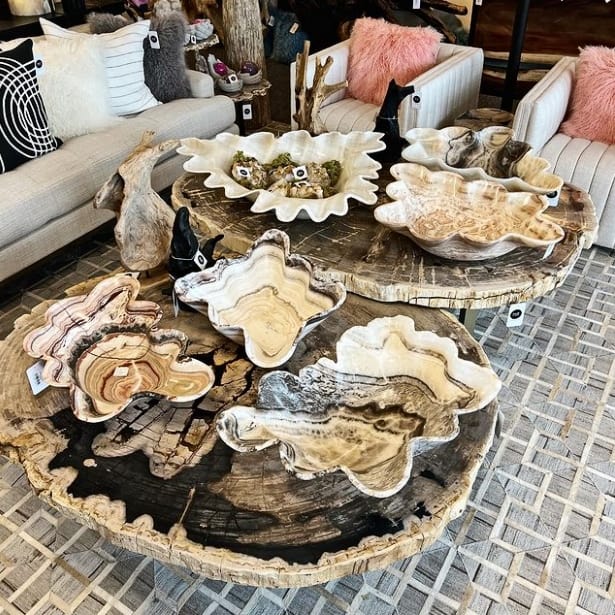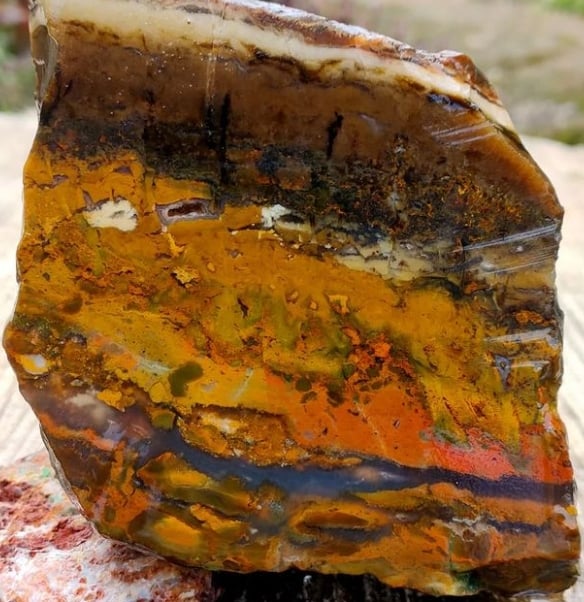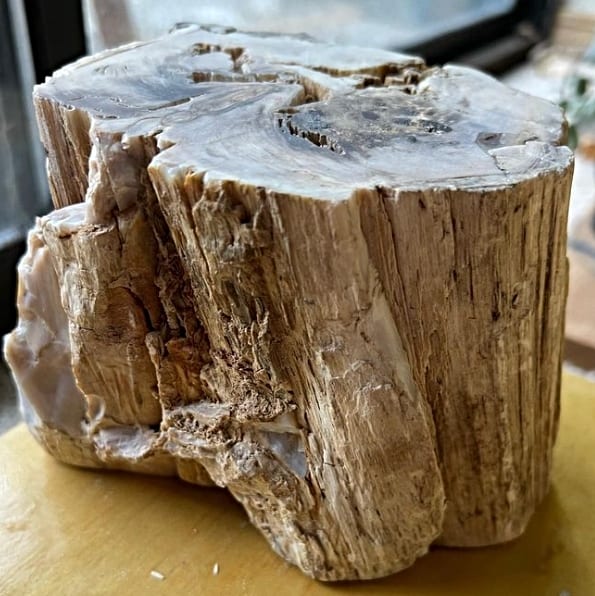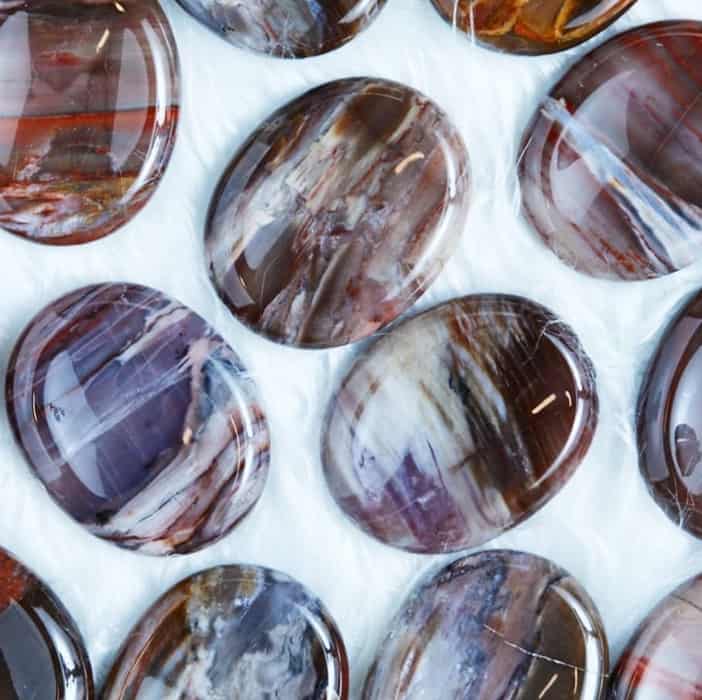Petrified wood is very popular among rock and mineral enthusiasts because you’re holding a piece of history in your hand. At one time the piece of wood was alive and growing and now you hold it in your hand and it’s a rock. Kind of cool when you let your imagination go.
Petrified wood is usually worth $.25 per pound. This means a small specimen costs between $2.00-$4.00. However, rare varieties such as opalized and green petrified wood can cost much more. The rarer and more exotic the specimen, the more it’s worth.
Is it legal to sell your petrified wood? Can you take samples from national parks? Is gold ever found in petrified wood? Keep reading to learn all about the value of petrified wood!

How Much is Petrified Wood Worth Per Pound?
Petrified wood usually goes for between $.25-$2.00 per pound. However, you can expect to make as much as $10.00 per pound if it’s a rare piece of high value. Typical pieces are usually the cheapest kinds, but depending on the market, you could get more per pound.
Texas petrified wood is worth $0.25 – $2.50 per pound depending on color and pattern. If it’s polished then expect to pay $1.00 – $3.00 per gram.
Petrified palm wood is worth $0.25 – $1.75 per pound depending on color and pattern. If it’s polished then expect to pay $0.50 – $2.00 per gram.
Arizona petrified wood is worth $0.25 – $2.50 per pound depending on color and pattern. If it’s polished then expect to pay $1.00 – $3.00 per gram.
Petrified wood and vegetation are a type of fossil that forms when minerals gather to replace vegetation. Petrified wood requires particular conditions to develop correctly.
These conditions require an oxygen-deprived environment, essentially devoid of bacteria. Usually, this is triggered by forests getting covered by water and peat moss quickly, preventing decay. Or volcanic activity that covers the wood in oxygen-depriving ash, thus preserving it.
Some of the best examples of these preserved forests can be found in the American South West and Australia. The Petrified Forest National Park and Gilboa Fossil Museum are some of the best places to do this for yourself.
Most petrified wood is made of quartz crystal (or silica). This makes sense since most petrified wood is formed thanks to volcanic activity, which triggers the formation of quartz.
However, petrified wood can also be made from opal and calcite. Since these crystals are much rarer, they’re also far more valuable.
Opal petrified wood is also known as opalized petrified wood. This requires even more unique conditions to form properly than the typical silica wood. However, they are available and are some of the most beautiful specimens.

How Is Petrified Wood Value Determined?
The crystal composition strongly indicates the value of a petrified wood specimen. However, several other factors primarily based on its aesthetic appeal can impact its value. These include the size, ring designs from the tree, and how it was polished.
I just discussed how petrified wood could be composed of valuable crystals such as opal. This will obviously increase its value, but they’re relatively rare and aren’t the best option for regular sales.
Other factors that impact resale value include:
- The completeness of the specimen
- Where they’re found
- Coloration
- Ringlets
- Size
- Professionally polished
Small pieces of petrified wood make for excellent tourist souvenirs. However, they can usually only be sold for between $2-$3.00 dollars. However, a large, complete piece of petrified wood sells for much more.
You can sell these pieces by the pound and make between $3-$10.00 per pound. This value is determined by the overall quality of this piece.
If the tree rings are intact, the coloration is vibrant, and it was polished well, the price will be higher. You can sell it for a good profit when all of these factors come together in a single piece.

Is It Legal To Collect and Sell Petrified Wood?
It is legal to collect petrified wood as well as other small fossils. However, you will need a permit before selling what you collect, or you can face a hefty fine or jail time. You also must be cautious about where you collect the fossils. Not all public grounds permit collectors to take samples.
According to the U.S. Forest Service, most parks permit collectors to take small quantities of fossils. The fossils they permit people to take samples of include:
- Ichnofossils (footprints or other imprints in rock)
- Invertebrate fossils (Shells, etc.)
- Petrified wood
- Petrified plants
The National Parks Service also advises visitors to be aware of where they collect samples. For example, the Petrified Forest has extremely strict rules about collecting samples.
The U.S. Federal government protects this land. Collecting samples from this park or similar parks with the same regulations could cost you hundreds in fines.
If you wish to collect petrified wood to sell, you must obtain a special commercial permit. Check with the local, state, and federal government agencies to ensure you’re doing everything legally. Also, ensure you don’t use explosives or other highly damaging tools for extraction.

What Color Petrified Wood Is the Rarest?
Green petrified wood is the rarest variety in the world. This green color is not caused by the interior of the wood’s color is preserved. Rather, petrified wood turns green when it has been exposed to copper at some point during its formation.
Petrified wood comes in several colors and types, including:
Green and blue petrified wood usually have a significant amount of copper alloys and magnesium dioxide. This could have gotten trapped in the crystalline structure as it formed. Or this copper could have been in water or soil near the specimen, which contaminated it over time.
However, tan, brown, and black are far more common. The presence of silica causes tan and brown colorations. This silica preserves the natural color of the original tree.
Black petrified wood has high amounts of carbon and pyrite. This is usually caused by the wood being burned before fossilizing.
Last, white petrified wood is fairly common. It turns white because of the presence of silica dioxide, such as quartz.
Closing Thoughts
Petrified wood is a stone of grounding and protection to spiritualists. This is thanks to how it forms and preserves the wisdom and shape of a once-living tree.
Where is Petrified Wood Usually Found?
Petrified wood is usually found near dried water deltas, volcanoes, and peat bogs. These fossils require an oxygen-depleted environment with little to no bacteria. Being beneath sediment and other debris also protects these trees from tampering with animals and humans.
How Long Does It Take for Petrified Wood to Form?
Most petrified wood samples take between 5,000-10,000 years to form. This is due to the tree’s natural hardness and proclivity to infestation by bugs and bacteria. Most samples found today are much older than this time frame and date back over 100 million years.
Is Gold Found in Petrified Wood?
Gold is not commonly found in petrified wood, but it can happen. Samples taken from Nevada, Mexico, and New Mexico had pieces of veins of gold inside of them. Although, it’s more common to find copper and pyrite (fools gold) in petrified wood specimens.
- Identify Enstatite - March 12, 2024
- Identify Cerussite - March 3, 2024
- Identify Bytownite - February 18, 2024
